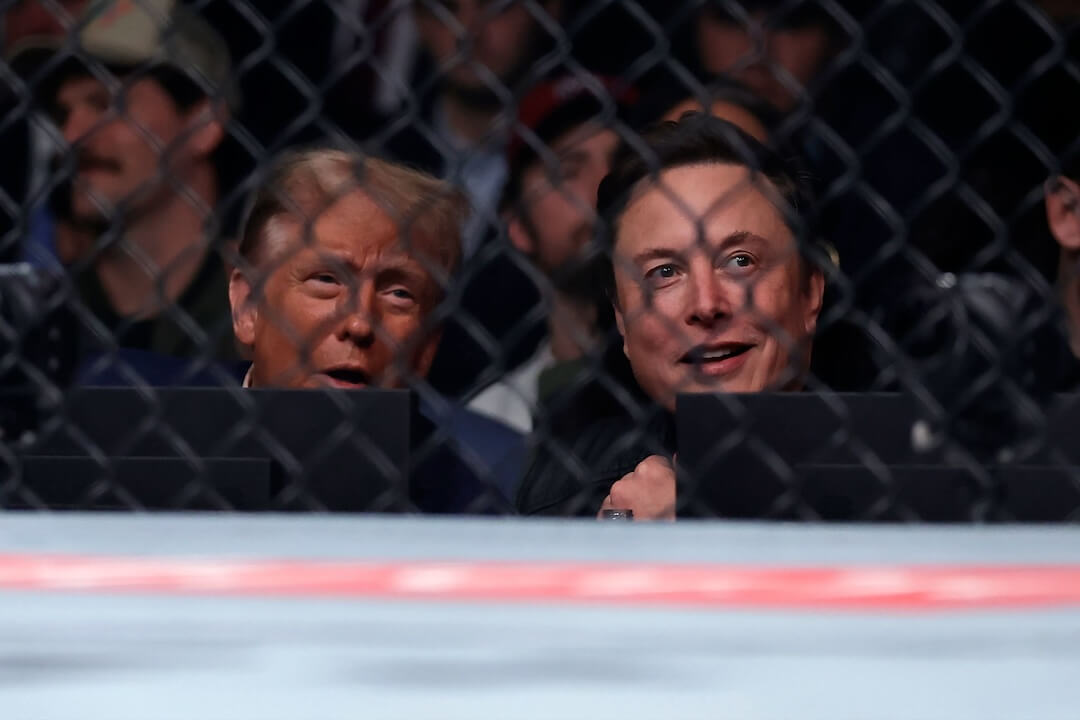Now that Donald Trump is the president-elect, could he actually go after what he commonly and consistently calls “the enemy of the people?”
You’ve heard his rhetoric. Fake News. Enemy of the people. Constant verbal attacks. He clearly has a disdain for the press.
Does he just say that stuff to rile up his supporters? Or does he mean it? Does he really plan to go to war with the press?
Uh, it’s real, says Kelly McBride, Poynter’s senior vice president and chair of the Craig Newmark Center for Ethics and Leadership. She and Poynter managing editor Ren LaForme were my guests on the latest “Poynter Report Podcast,” which debuts today. (Listen on Apple Podcasts, Spotify or Amazon Music, and don’t forget to leave us a rating and review.)
McBride says on the podcast that there are three things that Trump can do once he becomes president:
- “The first is he may try and influence federal regulation that will affect the owners of media; so licensing of broadcasting and then other owners who have other business interests,” McBride said. Think Jeff Bezos, who owns The Washington Post and other businesses, including Amazon.
- Two, McBride says, “He can order the Justice Department to go after anonymous sources of reporters. (The Justice Department) can subpoena reporters and threaten them with jail if they don’t reveal their sources. That will both hurt those individual reporters and those organizations, and it will have a chilling effect, because it will make sources less likely to come forward, and it will make other journalists less likely to push hard on vigilant coverage.”
- And, three, McBride says, “He can use the Sedition Act to go after leakers. He can persecute people who want to get information out to the public. So if you think about one of the biggest stories out of his first administration was the child separation, right? Stuff that was leaked initially about that, and then a lot of information was leaked — he could go after all of those people and threaten them with sedition charges for destabilizing government security. … That will intimidate the immediate people, and it will have a chilling effect on people down the road. So he can do a lot to intimidate or destabilize the environment in which reporting happens.”
Should we be nervous about all this?
LaForme said, “Trump is not a terribly disciplined person, so I don’t think we’ll see all of it, unless he really leans into this. But the business of journalism ain’t good. We write about that every day, right? There are some bright spots. … It’s local folks who really care, who are doing great work. But overall, the structure that underpins some of the legacy news organizations is looking pretty rickety, and I think we’ll see some of it collapse. I’m nervous.”
We talk about plenty more, including how the media did with covering the campaigns of Trump and Kamala Harris, if Trump and Harris were both covered equally and fairly, the impact new media (such as podcasts) played in the campaigns; and that dreaded word of every election coverage: polling.
And McBride and LaForme also offer their thoughts on what the press can do to combat Trump if he is hellbent on going after them.
I think you’ll find this latest episode to be especially interesting as we put a lid on election coverage and open a lid on what media coverage might look like in the second Trump administration.
A legend moves on
Ann Selzer, the respected pollster, announced in a column on Sunday that she is retiring from The Des Moines Register’s famed Iowa Poll. The announcement comes just a couple of weeks after the Register’s shocking final election poll had Kamala Harris leading Donald Trump by three points in Iowa. That poll turned out to be spectacularly wrong after Trump easily won the state by 14 points.
However, Selzer, 68, said she told the Register more than a year ago that she would be retiring after the 2024 election. She wrote, “Would I have liked to make this announcement after a final poll aligned with Election Day results? Of course. It’s ironic that it’s just the opposite. I am proud of the work I’ve done for the Register, for the Detroit Free Press, for the Indianapolis Star, for Bloomberg News and for other public and private organizations interested in elections. They were great clients and were happy with my work.”
The final Iowa poll notwithstanding, Selzer has always been considered a top-notch pollster. She wrote in her column, “Polling is a science of estimation, and science has a way of periodically humbling the scientist. So, I’m humbled, yet always willing to learn from unexpected findings.”
She later added, “My integrity means a lot to me. To those who have questioned it, there are likely no words to dissuade.”
Celebrating journalism
The Poynter Institute honored ABC News’ “Good Morning America” co-host Robin Roberts this past Saturday with the Poynter Medal for Lifetime Achievement in Journalism. Roberts was honored in Tampa at Poynter’s annual Bowtie Ball.
The gala also recognized journalists who were a part of the coverage of two hurricanes that impacted the Tampa Bay area, as well as journalists from AL.com, which won the 2023 Pulitzer Prize for Local Reporting.
My Poynter colleague Angela Fu talked with Roberts and has all the details in her story from the Bowtie Ball.
Inside the deal
In a seismic sports TV development, TNT’s “Inside the NBA,” considered among the best sports studio shows ever, will shift over to ESPN next season. At least occasionally. It’s the result of a settlement between the NBA and Warner Bros. Discovery, the owners of TNT, following a lawsuit involving future NBA rights. TNT lost out on the rights in the latest round of negotiations.
The Wall Street Journal’s Joe Flint, who broke the story, wrote, “The accord gives Warner Bros. Discovery the ability to develop new shows with NBA content in the U.S. and abroad, and international NBA rights in parts of Northern Europe and Latin America excluding Mexico and Brazil. The deal is expected to be announced early next week. While Warner Bros. Discovery is losing rights to regular and postseason games for its TNT network after this season, the settlement will give it rights to a significant amount of NBA content domestically and abroad, the people said, and the league will avoid a continued legal battle in court.”
The good news is that “Inside the NBA” — which stars Charles Barkley, Kenny Smith, Shaquille O’Neal and host Ernie Johnson — will remain on the air. Although that, too, is a bit complicated. The Washington Post’s Ben Strauss wrote, “The deal for ‘Inside the NBA’ is a licensing agreement. The talent and crew will remain Turner employees, and its Atlanta studio will still handle production. The show will not appear weekly on ESPN and ABC, as it did on TNT, but only for key events throughout the season such as opening night and the playoffs. ‘Inside the NBA’ will no longer air on TNT, but Barkley, Smith, O’Neal and Johnson probably will appear in other formats across Warner platforms.”
Of course, this all raises some questions.
The biggest is this: “Inside the NBA” has always brushed up against the edge of good taste and political correctness. Will ESPN be OK with that? (The fact that it lets Pat McAfee be himself indicates it might allow the “Inside the NBA” crew a bit of leeway.)
In addition, Awful Announcing’s Matt Yoder asks what effect this might have on ESPN’s Stephen A. Smith. Yoder writes, “(Smith) has been the central focus of ESPN’s NBA studio coverage in recent years, even going to ridiculous levels of showing him walking into the arena like he was one of the players! Will ESPN want Stephen A. Smith to be part of the Inside the NBA crew, or will the TNT crew truly be allowed to exist in its own universe? Smith has made some crossover appearances on TNT before and seems to be friendly with them. But it would certainly change the dynamic if his very large personality tried to fit in on a regular basis with such a well-oiled machine.”
Fighting problems

Jake Paul lands a left to Mike Tyson during their heavyweight boxing match on Friday in Arlington, Texas. (AP Photo/Julio Cortez)
Friday’s so-called “fight” between YouTuber/boxer Jake Paul and 58-year-old former heavyweight champ Mike Tyson on Netflix had a little of the expected, a bit of the unexpected and now some controversy.
First, the expected: Tyson looked every single day of 58 years old. Anyone who thought that a 58-year-old man who hasn’t had a serious boxing match since 2005 could be competitive surely was fooling themselves. Even though the match had two-minute rounds (as opposed to the normal three) and was scheduled for only eight rounds, Tyson looked terribly winded halfway through the match, to the point where you kept wondering if he would be able to get off his stool for the next round.
In the end, it was a dull and awful fight, with Tyson landing only 18 punches and Paul, perhaps out of respect for Tyson, holding back so as to not embarrass the boxing legend. Paul won a unanimous decision in a fight that ended with boos from the 72,000-plus at AT&T Stadium — home of the Dallas Cowboys.
So all of that was expected. Put it this way: If you thought this would be an exciting fight, that’s on you, not the boxers.
The unexpected part, however, was the broadcast, most notably how Netflix struggled to meet the moment.
Writing for his Substack, NPR TV critic Eric Deggans wrote, “But man, did Netflix drop the ball everywhere else. Presumably because so many people were trying to watch the fight, I experienced the kind of serious technical issues lots of other fans complained about on social media – images which would freeze for long seconds or grow fuzzy, sound which would get thin and distant without warning, and moments when I’d just get kicked off the livestream completely, forcing me to go back to Netflix’s home page and re-enter.”
I had the same experience, having to reload Netflix several times during the evening. And so did many others, judging by the deluge of comments on social media.
Now the controversy. Netflix claims that more than 60 million households watched the fight, peaking at 65 million concurrent streams. But Fox Sports president of insights and analytics Mike Mulvihill pointed out that it was Netflix and not Nielsen that provided that number, tweeting on Saturday, “Nielsen is fully capable of producing a U.S.-only viewership number for Netflix on a next day basis but they can’t do it if Netflix doesn’t ask for it.”
On Sunday, Mulvihill tweeted, “To be clear, the intent of the tweet cited here wasn’t to suggest I do or don’t believe the Netflix claim of 60m homes worldwide. It’s only to point out that a US number could easily have been produced by Nielsen but it wasn’t ordered.”
Sports Business Journal editor/writer Austin Karp tweeted, “Sorry but I just can’t really trust internal-only Netflix numbers for Tyson-Paul (plus the numbers reported are global). I’m sure true numbers would’ve been good, but we may likely never know. Reported numbers aren’t 3rd-party verified and there’s every incentive for exaggeration.”
Regardless, it’s safe to assume that the fight drew huge traffic numbers. So the real concern is how viewers had such a frustrating experience with constant freezing and buffering. Netflix better figure it out quickly. On Christmas Day, it will air two NFL games, including what is setting up to be a marquee matchup between the Pittsburgh Steelers and Kansas City Chiefs. The other game figures to be good, too: Houston vs. Baltimore.
The Athletic’s Richard Deitsch wrote, “The NFL wants to put on a show far more entertaining than Tyson-Paul, and you can be sure Friday night spooked league officials a bit. Given the trajectory of the four teams playing Christmas Day, the games are shaping up to be of serious consequence for playoff seeding. There is money and reputation at stake, and you don’t get a second chance at a first impression. Both entities will be crushed by NFL fans if Christmas brings buffering and dropped streams.”
Media tidbits
- The Washington Post’s Jacqueline Alemany, Jeff Stein and Maegan Vazquez with “Musk appears to pressure Trump on Cabinet and tariffs, irking advisers.”
- And for The Daily Beast, Zachary Folk with “Battle Over Trump’s Treasury Sec Gets Messy as Musk Puts Thumb on the Scale.”
- The New York Times’ Sheera Frenkel with “Liberals Are Left Out in the Cold as Social Media Veers Right.”
- Tampa Bay Times executive editor Mark Katches with “Why did the Tampa Bay Times reprint a poster page after Donald Trump won the presidency?”
Hot type
Just one story here this morning because I want you to take a few minutes to watch it. From “CBS News Sunday Morning,” correspondent Steve Hartman and photographer Lou Bopp go into the homes of families who lost children to school shootings. They are there to take a portrait of the bedrooms of the children. Please watch “How do you make a portrait of a child who isn’t there? Photographer Lou Bopp found a way, but it wasn’t easy.”
More resources for journalists
- Transform your crime coverage while helping your community.
- Encourage an outstanding colleague to apply for Leadership Academy for Women in Media.
- Are you an up-and-coming newsroom manager?
Have feedback or a tip? Email Poynter senior media writer Tom Jones at tjones@poynter.org.
The Poynter Report is our daily media newsletter. To have it delivered to your inbox Monday-Friday, sign up here.







Comments